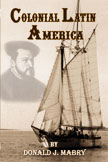Conquest and Settlement Patterns
© 2001 Donald J. Mabry
Rapidity of Exploration
- Exploration of North America (north to Kansas and Colorado and into South Carolina)
and of South America took less than 75 years.
- The exploration enabled the Spanish to identify the existing resources and
concentrate what they wanted.
- Like most 16th century Europeans, the Spanish wanted precious metals and people to
work for them.
- Thus, the pattern of conquest also established the settlement patterns.
Conquest Patterns
The Caribbean:
- Cuba, Puerto Rico, and Hispaniola to control the entrances to the Caribbean and the
Gulf of Mexico.
- Settled Darién and Panama City to control the Isthmus of Panama.
- Established Cartegena on the north coast of Colombia as a Caribbean fort.
- Took assorted Caribbean islands as needed.
Mexico:
- Established Vera Cruz as the chief port of New Spain.
- Established Puebla on the route to Mexico City.
- Built Mexico City on the ruins of Tenochtitlán.
- Spread into central Mexico and westward to found Guadalajara.
- The conquest of northern Mexico (San Luis Potosí northwards) was slower because of
the fierce nomadic Amerinds, except for important mining areas such as Zacatecas.
- Moved into California and Texas in the 18th century after LaSalle's explorations in
1683.
- Movement into Oaxaca and the Yucatán was slow.
Guatemala was settled by the Spanish quickly, for there were plenty of
sedentary people to put to work. Most of Central America was sparsely populated and
contained few precious metals.
South America
- Peru settled by Pizarro, Almagro, and company. The civil war slowed the process for a
generation. Peru had valuable mines and a very large sedentary population. It was the most
important Spanish South American colony.
- Ecuador, Bolivia, and Chile were sparsely settled by the Spanish.
- Colombia and Venezuela were important because they bordered the Caribbean and pearls
were obtained in Venezuela. There was also some cattle raised and sold in Venezuela.
- Argentina was a backwater until the later 18th century.
The rationale of the settlement pattern
- They took the areas where they found precious metals such as gold and silver.
- They took control, of sedentary Amerinds who were accustomed to working under
direction.
- Established tropical plantations to grow sugar, tobacco, and cotton in time.
- Established places from which they could supply towns, routes, and mines with food,
mules, donkeys, etc.
- They expanded into areas as a defensive measure, particularly in the late 18th and
early 19th centuries.
The Spanish were town dwellers. Established towns immediately and laid them out with
the latest avant garde town planning and architecture. Used town squares. They segregated
the Amerinds into neighborhoods different from their own except, of course, for the
live-in servants. Some towns were both Indian and Spanish, such as Mexico City and Cuzco,
whereas others, such as Puebla and Lima, were overwhelmingly Spanish. Whenever possible,
they sought access to the sea.
The settlement patterns of the conquest period
established the pattern for the colonial period. After that, it was a matter of
"filling in" to meet needs.
You can read about other topics in colonial Latin American history by buying and reading
 Colonial Latin America by Don Mabry.
Colonial Latin America by Don Mabry.
Click on the book cover or the title to go to Llumina Press.

